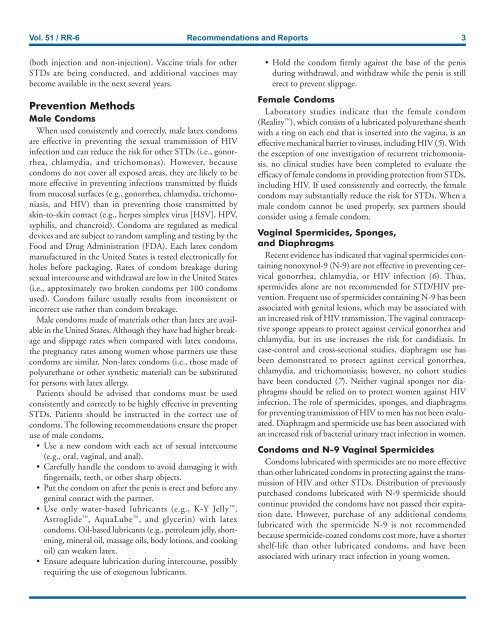You also want an ePaper? Increase the reach of your titles
YUMPU automatically turns print PDFs into web optimized ePapers that Google loves.
Vol. 51 / RR-6 Recommendations and Reports 3<br />
(both injection and non-injection). Vaccine trials for other<br />
STDs are being conducted, and additional vaccines may<br />
become available in the next several years.<br />
Prevention Methods<br />
Male Condoms<br />
When used consistently and correctly, male latex condoms<br />
are effective in preventing the sexual transmission of HIV<br />
infection and can reduce the risk for other STDs (i.e., gonorrhea,<br />
chlamydia, and trichomonas). However, because<br />
condoms do not cover all exposed areas, they are likely to be<br />
more effective in preventing infections transmitted by fluids<br />
from mucosal surfaces (e.g., gonorrhea, chlamydia, trichomoniasis,<br />
and HIV) than in preventing those transmitted by<br />
skin-to-skin contact (e.g., herpes simplex virus [HSV], HPV,<br />
syphilis, and chancroid). Condoms are regulated as medical<br />
devices and are subject to random sampling and testing by the<br />
Food and Drug Administration (FDA). Each latex condom<br />
manufactured in the United States is tested electronically for<br />
holes before packaging. Rates of condom breakage during<br />
sexual intercourse and withdrawal are low in the United States<br />
(i.e., approximately two broken condoms per 100 condoms<br />
used). Condom failure usually results from inconsistent or<br />
incorrect use rather than condom breakage.<br />
Male condoms made of materials other than latex are available<br />
in the United States. Although they have had higher breakage<br />
and slippage rates when compared with latex condoms,<br />
the pregnancy rates among women whose partners use these<br />
condoms are similar. Non-latex condoms (i.e., those made of<br />
polyurethane or other synthetic material) can be substituted<br />
for persons with latex allergy.<br />
Patients should be advised that condoms must be used<br />
consistently and correctly to be highly effective in preventing<br />
STDs. Patients should be instructed in the correct use of<br />
condoms. The following recommendations ensure the proper<br />
use of male condoms.<br />
Use a new condom with each act of sexual intercourse<br />
(e.g., oral, vaginal, and anal).<br />
Carefully handle the condom to avoid damaging it with<br />
fingernails, teeth, or other sharp objects.<br />
Put the condom on after the penis is erect and before any<br />
genital contact with the partner.<br />
Use o<strong>nl</strong>y water-based lubricants (e.g., K-Y Jelly ,<br />
Astroglide , AquaLube , and glycerin) with latex<br />
condoms. Oil-based lubricants (e.g., petroleum jelly, shortening,<br />
mineral oil, massage oils, body lotions, and cooking<br />
oil) can weaken latex.<br />
Ensure adequate lubrication during intercourse, possibly<br />
requiring the use of exogenous lubricants.<br />
Hold the condom firmly against the base of the penis<br />
during withdrawal, and withdraw while the penis is still<br />
erect to prevent slippage.<br />
Female Condoms<br />
Laboratory studies indicate that the female condom<br />
(Reality ), which consists of a lubricated polyurethane sheath<br />
with a ring on each end that is inserted into the vagina, is an<br />
effective mechanical barrier to viruses, including HIV (5). With<br />
the exception of one investigation of recurrent trichomoniasis,<br />
no clinical studies have been completed to evaluate the<br />
efficacy of female condoms in providing protection from STDs,<br />
including HIV. If used consistently and correctly, the female<br />
condom may substantially reduce the risk for STDs. When a<br />
male condom cannot be used properly, sex partners should<br />
consider using a female condom.<br />
Vaginal Spermicides, Sponges,<br />
and Diaphragms<br />
Recent evidence has indicated that vaginal spermicides containing<br />
nonoxynol-9 (N-9) are not effective in preventing cervical<br />
gonorrhea, chlamydia, or HIV infection (6). Thus,<br />
spermicides alone are not recommended for STD/HIV prevention.<br />
Frequent use of spermicides containing N-9 has been<br />
associated with genital lesions, which may be associated with<br />
an increased risk of HIV transmission. The vaginal contraceptive<br />
sponge appears to protect against cervical gonorrhea and<br />
chlamydia, but its use increases the risk for candidiasis. In<br />
case-control and cross-sectional studies, diaphragm use has<br />
been demonstrated to protect against cervical gonorrhea,<br />
chlamydia, and trichomoniasis; however, no cohort studies<br />
have been conducted (7). Neither vaginal sponges nor diaphragms<br />
should be relied on to protect women against HIV<br />
infection. The role of spermicides, sponges, and diaphragms<br />
for preventing transmission of HIV to men has not been evaluated.<br />
Diaphragm and spermicide use has been associated with<br />
an increased risk of bacterial urinary tract infection in women.<br />
Condoms and N-9 Vaginal Spermicides<br />
Condoms lubricated with spermicides are no more effective<br />
than other lubricated condoms in protecting against the transmission<br />
of HIV and other STDs. Distribution of previously<br />
purchased condoms lubricated with N-9 spermicide should<br />
continue provided the condoms have not passed their expiration<br />
date. However, purchase of any additional condoms<br />
lubricated with the spermicide N-9 is not recommended<br />
because spermicide-coated condoms cost more, have a shorter<br />
shelf-life than other lubricated condoms, and have been<br />
associated with urinary tract infection in young women.


